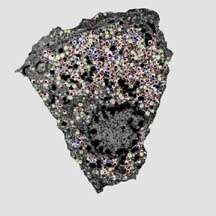| Information technology, diagnostic imaging | |||
NASA satellite imaging technology used in fight against diabetes25 June 2006 Technology that identifies landforms, geology and vegetation types from satellite images of the earth's surface has been used to help identify insulin-related structures in electron microscope images of the pancreas. Scientists at The George Washington University, Washington, and Cornell University, Ithaca, N.Y., helped modify the NASA technology, which has greatly increased the speed of the research.
The team analyzed electron photomicrographs of beta cells from rats. The hormone insulin, which regulates blood glucose levels, is manufactured in beta cells in the pancreas. Microscopic structures called granules carry insulin toward the cell wall of the beta cells, where it is secreted in response to glucose levels in the blood. The image analysis technology was adapted to identify biological structures, the insulin granules, in electron photomicrographs. The research team observed the number, size, and position of insulin granules in the beta cells in response to glucose, which cells use for energy. "Previously, the analysis of each electron micrograph took an assistant several hours to complete. Now, with the image processing software, we can automatically analyze several dozen electron micrographs overnight," said Tim McClanahan, a scientist at NASA's Goddard Space Flight Center in Greenbelt, Md. "NASA technology combined with our modifications has provided us with new tools for fighting diabetes," said Murray Loew, director of the Biomedical Engineering Program and professor of engineering at The George Washington University's School of Engineering and Applied Science. Diabetes afflicts more than 20 million Americans. It is caused by the body's inability to regulate glucose. Insulin regulates glucose by unlocking the interior of cells and allowing glucose in blood to pass through the cell wall. Two types of diabetes exist. In Type I diabetes, pancreatic cells are destroyed. In Type II diabetes, either pancreatic cells don't secrete enough insulin, or cells in the body lose their responsiveness to insulin, or both problems happen at once. Both types of diabetes cause glucose to build up in the blood instead of being delivered to the interior of cells, where it is needed or would be stored. Life-threatening effects include coma, heart disease, kidney damage, nerve damage, blindness, and loss of limbs. We plan on an extensive collaboration in the future. The potential for this research is excellent," said Geoffrey Sharp, a diabetes expert in the Department of Molecular Medicine at Cornell University. The team has submitted proposals to the National Institutes of Health and the American Diabetes Association to further validate the technology with additional data and to extend the work to identify and characterize other microscopic cellular structures.
|
